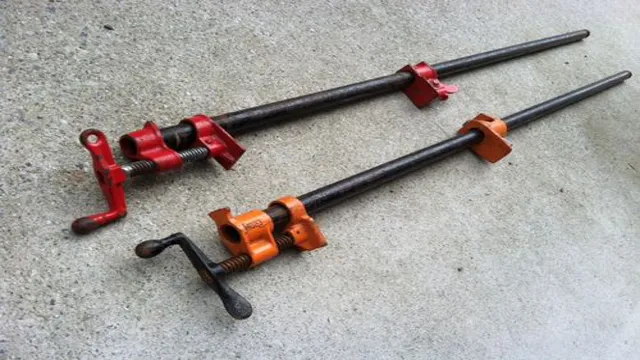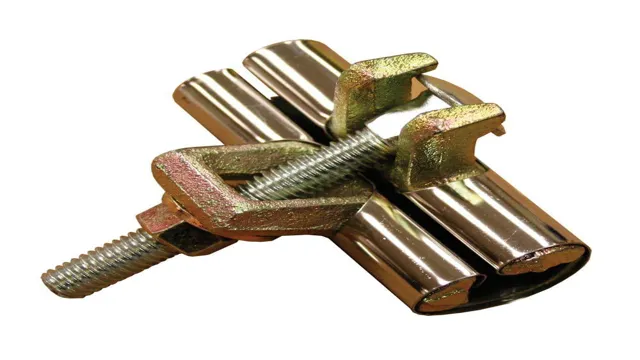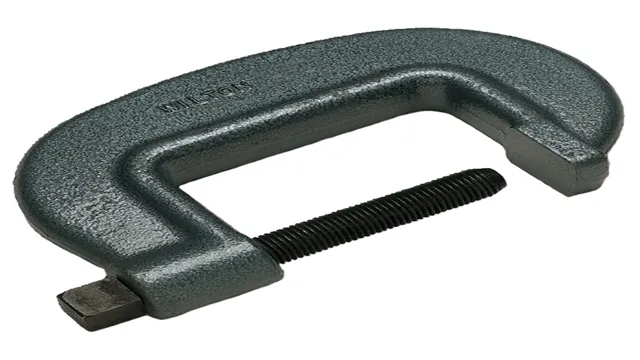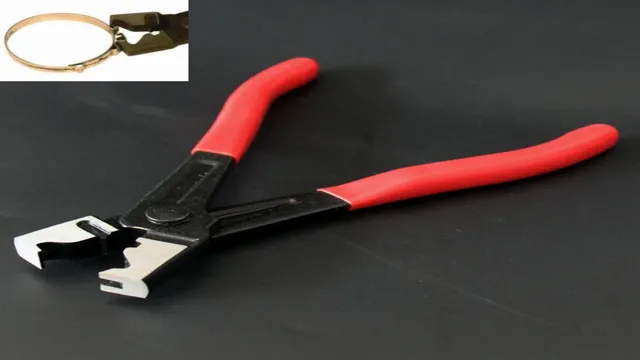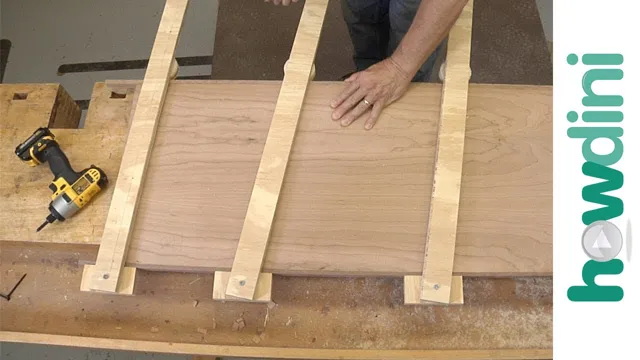How Do You Store Clamps Efficiently and Conveniently? Discover the Best Techniques!
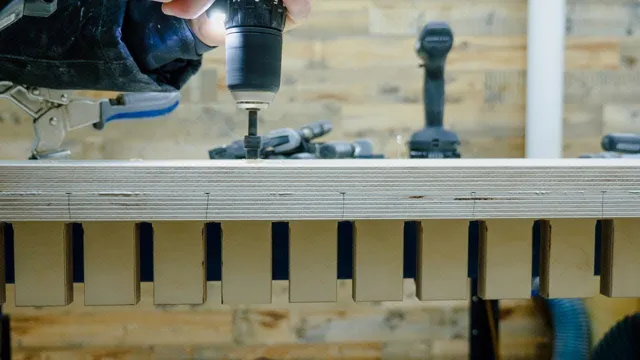
As a handyman, you know it’s essential to keep your tools organized and accessible. One of the most crucial tools in your workshop is undoubtedly your clamps. They come in different shapes and sizes, from spring clamps to bar clamps, and keeping them in order can be overwhelming.
Luckily, there are many effective ways to store your clamps that will not only make your workshop look organized but also save you time when you need them. In this blog, we’ll explore five practical ways to store your clamps and keep them ready for your next project. So, let’s dive in!
Introduction
If you’re a woodworking enthusiast, you know how important it is to have your clamps organized and easily accessible. Storing clamps can be a challenge, but there are a few methods you can use to keep them in order. One option is to build a clamp rack using wood or metal brackets mounted on a wall.
Another option is to use a pegboard, attaching hooks and brackets to hang your clamps. Additionally, you may consider using a tool chest with drawers, creating custom foam insets to hold your clamps securely. Whichever method you choose, it’s important to keep your clamps free of dirt and debris, wiping them down after each use.
By taking the time to organize and store your clamps properly, you’ll save time and frustration on your woodworking projects.
Importance of Proper Storage for Clamps
Clamps storage Have you ever experienced frustration while trying to find the right clamp for your project, only to realize that it is damaged or rusted? This can be a common issue if proper storage for clamps is not implemented. Proper storage for clamps is crucial in ensuring their longevity and avoiding unnecessary replacements. When clamps are not stored appropriately, they can be damaged by moisture, temperature, or dust particles, leading to rust or deformation.
Therefore, it is important to take the time to organize and store your clamps in a dry and clean place, away from direct sunlight or sources of heat. This will contribute significantly to keeping your clamps in good condition and enhancing their performance, without the expense of frequent replacements or repairs. Invest in proper storage for clamps, and save yourself the headache of damaged clamps, enabling you to complete your projects with confidence.
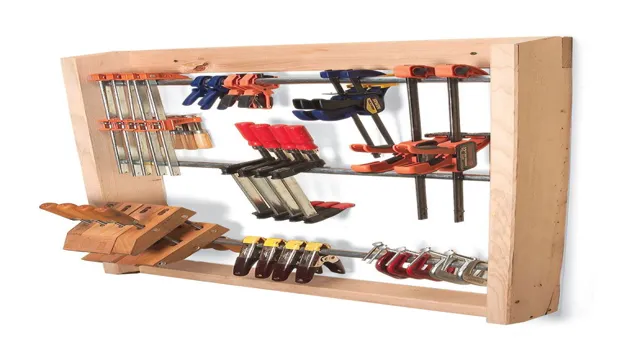
Factors to Consider When Choosing a Clamp Storage Method
When it comes to choosing a clamp storage method, there are several factors to consider to ensure that your clamps are stored safely and easily accessible. Most importantly, you will need to consider the size and quantity of the clamps you own as well as the space you have available for storage. Based on these factors, you can decide whether you want to opt for a wall-mounted clamp rack, a clamp cart, or a standalone clamp holder.
Additionally, you will want to think about the type of clamp you have and whether specialized storage solutions are required. For example, spring clamps are best kept in loops, whereas c-clamps need a more solid surface to rest on. Ultimately, the key to choosing the right clamp storage method is to prioritize functionality and ease of use, so that you can focus on your woodworking projects without having to worry about misplaced clamps.
5 Ways to Store Clamps
Storing clamps can be a challenging task, especially if you have a large collection of different sizes and types. Fortunately, there are several ways you can store your clamps to ensure they remain organized and easily accessible. One option is to build a clamp rack or holder that can be mounted on a wall or stored on a bench.
This allows you to keep your clamps in a dedicated space that is easy to reach and keeps them from getting lost or damaged. If you don’t have the space or resources to build a rack, consider using a sturdy toolbox or tool chest to keep your clamps organized. Another effective storage option is to use a pegboard or slat wall system, which allows you to easily hang your clamps and other tools in an organized and easily accessible manner.
No matter which storage method you choose, be sure to label your clamps and keep them organized by type and size to make it easier to find the clamp you need when you need it. With a little creativity and organization, you can keep your clamps well-organized and easily accessible.
1. Wall-mounted rack
If you’re looking for a space-saving solution for your clamp storage, a wall-mounted rack might just do the trick! Not only does it keep your clamps organized and easily accessible, but it also frees up valuable floor space in your workshop or garage. A wall-mounted rack can hold a variety of clamps, from spring clamps to bar clamps, and can easily be customized to fit your specific needs. Plus, installation is a breeze with just a few screws and a drill.
Say goodbye to cluttered workspaces and hello to efficient clamp storage with a wall-mounted rack!
2. Pegboard
When it comes to organizing clamps in a workshop, pegboard is an excellent option. There are various ways to store clamps on pegboard, making it effortless to find the exact tool you need. One such way is to use straight hooks, which are perfect for holding all types of clamps.
You can also use double or single prong hooks to hang larger and heavier clamps. Another option is to use specialized clamp holders that are designed to keep specific types of clamps organized. For instance, pipe clamp holders keep pipe clamps neatly organized and easily accessible.
Additionally, you can use spring clamps to hold objects such as cords, wires, or tubing to the pegboard. Pegboard also allows for customization and flexibility, letting you move the clamps around as needed. Overall, pegboard is an excellent way to keep clamps organized and easily accessible, ensuring that your projects run smoothly.
3. Toolbox or cabinet
If you’re a DIY enthusiast and frequently work with clamps, finding a way to store them effectively is essential. One of the most popular options is to use a toolbox or cabinet designed for the specific purpose of organizing your tools. These come in all shapes and sizes, and you can purchase models with various compartments and drawers to store your clamps separately.
This method is perfect for individuals who require portability with their tools. You will have quick access to your clamps since you can carry them anywhere you need to work. However, it’s essential to ensure that you invest in durable and high-quality toolboxes or cabinets that will withstand the weight of your clamps without wearing out easily.
Additionally, you’ll want to think carefully about the size of the toolbox or cabinet you choose, as you don’t want to purchase an oversized model that is challenging to move around. By doing some research and investing in a sturdy toolbox or cabinet, you can ensure that your clamps are organized and easily accessible whenever you need them.
4. Magnetic bar
If you’re someone who uses clamps regularly, it’s important to have a system for storing them that keeps them organized and easily accessible. Here are five simple ways to store your clamps: Pegboard: Installing a pegboard on your workshop wall is an excellent way to store clamps.
You can hang hooks at different heights and arrange them in a way that makes sense for the size and types of clamps you use. Clamp rack: A clamp rack is a must-have if you have a lot of different types of clamps.
You can create your own using wood or metal bars, or purchase a pre-made one online. Bucket: For a quick and easy storage solution, use a bucket.
You can keep it on the floor or on a shelf, and simply toss your clamps in. Just be sure to label the bucket so you can find what you need quickly.
Magnetic bar: Clamps with metal bodies can be stored on a magnetic bar. This is another easy way to keep them organized, and you can mount the bar on the wall or the side of your workbench.
Mobile cart: If you need to move your clamps around your workshop frequently, a mobile cart is a great option. You can build your own using wood or metal, or purchase a pre-made one with different configurations. No matter which storage solution you choose, just be sure to keep your clamps in good condition by cleaning them regularly and storing them in a dry, cool place.
5. Clamp cart
If you’re a DIY enthusiast or a professional woodworker, you know how important it is to have your clamps well organized, so you can quickly find the one you need. That’s where a clamp cart comes in handy. This simple and efficient storage solution can hold a large number of clamps in one place.
One of the biggest advantages of a clamp cart is that you can easily move it around your workshop. This means you don’t have to go back and forth to get a specific clamp, which saves you time and boosts your productivity. Another advantage is that the clamp cart helps you keep your workspace clean and clutter-free, as you won’t have to leave clamps lying around on your workbench or the floor.
So if you’re struggling with clamp storage, consider building or buying a clamp cart. It will make your woodworking projects much easier and more enjoyable.
Conclusion
In the world of woodworking, clamps are the unsung heroes of any project. But when not in use, storing these long and unwieldy tools can be a challenge. Just like arranging books on a shelf, a well-organized clamp storage system can make all the difference.
From vertical racks to horizontal drawers, the possibilities are endless. With a little creativity and ingenuity, you’ll have your clamps neatly stowed away and ready for action at a moment’s notice. So, don’t clamp up when it comes to storage, embrace your inner organization guru and get those clamps in tip-top shape!”
Summary of the Importance of Proper Clamp Storage
Proper clamp storage is crucial for maintaining the longevity and effectiveness of your clamps. Storing them haphazardly can lead to damage, corrosion, and decreased clamping force. Here are five ways to store your clamps properly:
Wall-mounted racks: These are perfect for keeping your clamps organized and within reach. They also take up minimal floor space.
Mobile carts: If you have a large number of clamps, a mobile cart can be a great way to keep them organized and easily movable. Custom cabinets or drawers: These can be useful if you have a specific layout in mind or prefer a more concealed storage option.
Magnetic strips: These are perfect for storing small clamps or for keeping your most-used clamps readily available.
Soft clamp covers: These can be a great option for protecting your clamps from damage while in storage. By utilizing proper storage techniques, you can save yourself the headache and expense of having to replace damaged or corroded clamps. Plus, you’ll have peace of mind knowing that your clamps are easily accessible and ready for your next project.
Don’t let poor storage ruin your clamps’ effectiveness – try one of these storage options today!
FAQs
What are the different types of clamps and their uses?
There are various types of clamps such as bar clamp, C-clamp, quick grip clamp, pipe clamp, and spring clamp, each designed for specific applications. Bar clamps are used for larger projects like furniture making, while C-clamps are ideal for holding together two pieces of metal. Quick grip clamps are perfect for one-handed use, and pipe clamps are used for holding pipes or long tubes. Spring clamps are ideal for holding smaller materials like craft projects.
How do you organize and store your clamps?
The best way to store your clamps is to keep them organized and off the ground. You can use a pegboard or a wall-mounted clamp rack to keep them within easy reach. It is also recommended to sort them by type and size, and use identifiers or labels to quickly find a specific clamp.
What do you do if your clamps become rusty or dirty?
If your clamps become rusty or dirty, you can clean them using a wire brush or a sandpaper. Then, you can apply a rust inhibitor to prevent rust from forming again. For quick cleaning, you can also use a mixture of baking soda and water or a vinegar solution.
Can I use my clamps for woodworking and metalworking?
Yes, many clamps are versatile and can be used for both woodworking and metalworking. However, some clamps may be more suitable for one application over the other. For example, C-clamps are ideal for metalworking, while bar clamps are perfect for woodworking.
Do I need to oil my clamps?
It is recommended to oil or lubricate your clamps from time to time to prevent them from rusting or corroding. You can use a light oil or silicone spray to keep them moving smoothly without leaving any residue.
Can clamps damage my project?
Improper use of clamps can damage your project. For example, using too much pressure can cause wood to split or warp, or metal to dent or bend. It is important to use the right type and size of clamp for your project, and tighten them just enough to hold the material securely in place without causing damage.
How do I know what size clamp to use?
The size of your clamp depends on the size of your project and the thickness of the material you are working with. As a general rule, choose a clamp that is at least one-third the length of the material being clamped. For example, a 12-inch bar clamp is suitable for clamping a 36-inch board.

